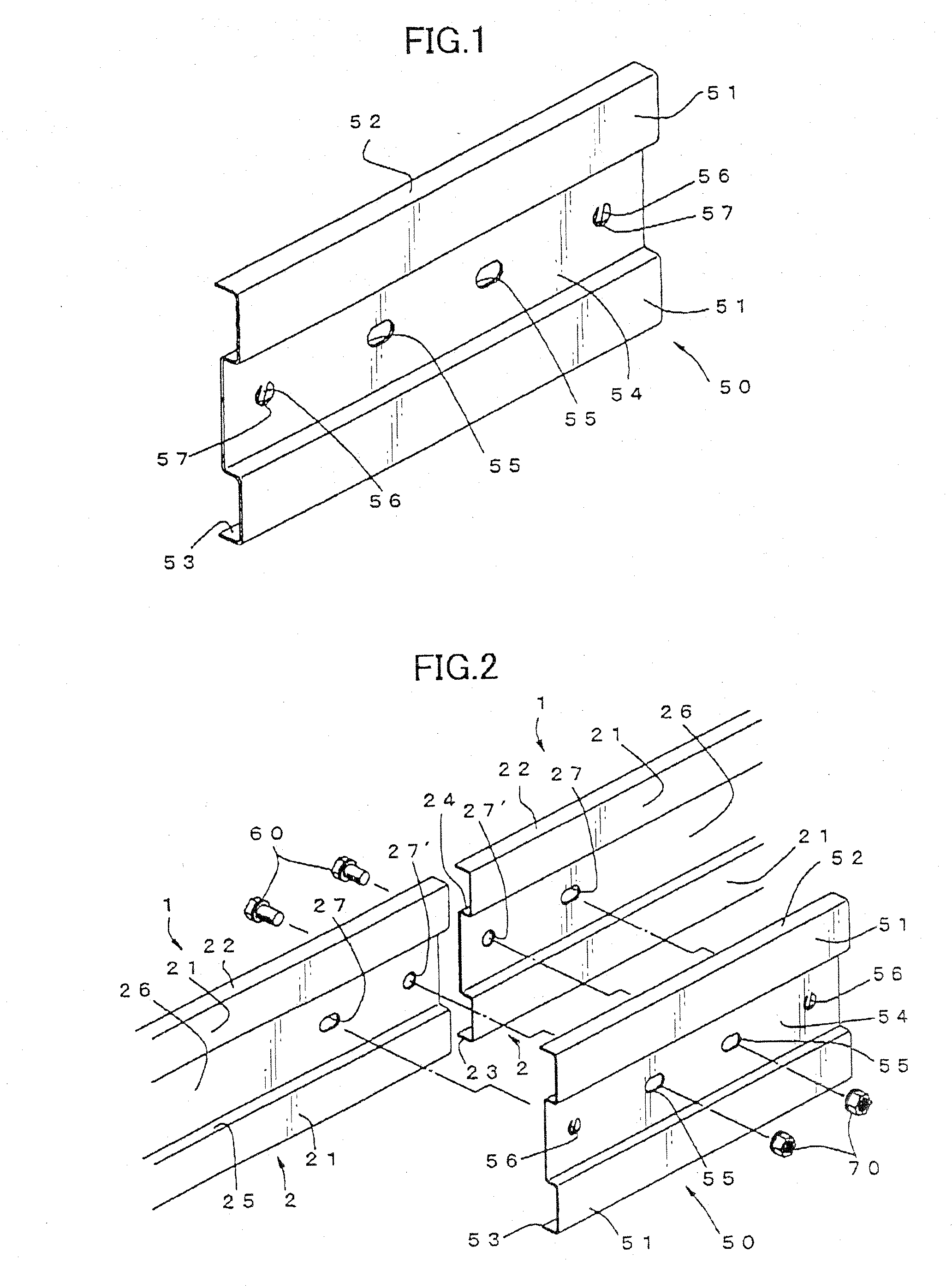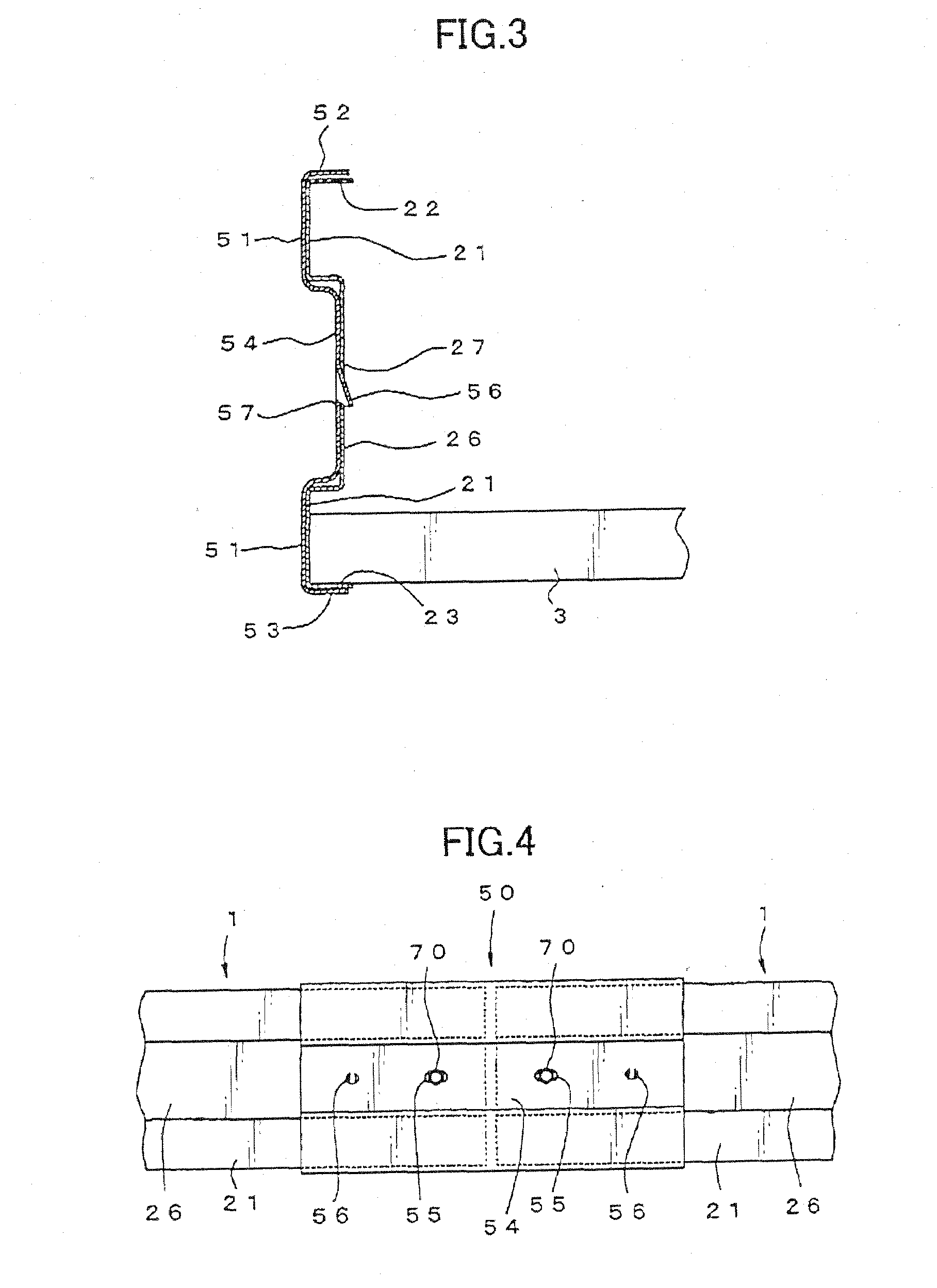Method of joining cable racks, and a splice plate
a technology of splicing plate and cable rack, which is applied in the direction of couplings, conveyors, rod connections, etc., can solve the problem of reducing the entire joining operation by half a time, and achieve the effect of reducing production costs
- Summary
- Abstract
- Description
- Claims
- Application Information
AI Technical Summary
Benefits of technology
Problems solved by technology
Method used
Image
Examples
first embodiment
[0034]With reference to the drawings, the present invention will now be described based on an embodiment thereof. FIG. 1 shows a splice plate according to the present invention.
[0035]As already described in connection with FIG. 10, a cable rack 1 has a ladder-like structure in which two primary beams 2 extending in parallel relation to each other are connected together by a plurality of secondary beams 3 disposed therebetween at certain intervals. In order to ensure desired strength, each of the primary beams 2 has first and second bent edge plate portions 22, 23 extending from respective upper and lower edges of a vertically planar plate portion 21 inwardly in a direction perpendicular to the planar plate portion 21, and a vertically planar depressed plate portion 26 formed by depressing a generally vertically central region of the planar plate portion 21 inwardly in a manner continuous with an upper step portion 24 and a lower step portion 25.
[0036]The two primary beams 2 position...
second embodiment
[0052]FIG. 5 shows a splice plate 80 according to the present invention, wherein the splice plate 80 is designed to join together two cable racks different in height dimension of a primary beam, in a longitudinal direction thereof.
[0053]Specifically, the splice plate 80 has a vertically planar plate 81 having low and high planar plate portions which are formed to have different height dimensions each conforming to a corresponding one of a longitudinally-aligned pair of primary beams 2 in two racks 1, and arranged in a longitudinal direction thereof; two first bent plate edge portions 82a, 82b extending from respective upper edges of the low and high planar plate portions in such a manner as cover respective adjacent ends of the longitudinally-aligned pair of primary beams 2; a second bent plate edge portion 83 extending from a common lower edge of the low and high planar plate portions in such a manner as cover respective adjacent ends of the longitudinally-aligned pair of primary b...
third embodiment
[0055]FIG. 6 shows a splice plate 90 according to the present invention, wherein the splice plate 90 is designed to join together respective adjacent ends of each of two longitudinally-aligned pairs of primary beams 2 in two cable racks, in such a manner that a longitudinal-lateral plane (a longitudinal plane including a plurality of secondary beams of the cable rack) of one of the cable racks 1 is inclined relative to that of the other cable rack 1. The splice plate 90 has first and second portions formed integrally to extend outwardly from a central region thereof at a certain inclination angle relative to each other.
[0056]Specifically, the splice plate 90 has a vertically planar plate 91 having first and second planar plate portions which are formed integrally at a certain inclination angle relative to each other; two first bent plate edge portions 92 extending from respective upper edges of the first and second planar plate portions of the planar plate portion 91 in such a manne...
PUM
| Property | Measurement | Unit |
|---|---|---|
| length | aaaaa | aaaaa |
| strength | aaaaa | aaaaa |
| thermal expansion | aaaaa | aaaaa |
Abstract
Description
Claims
Application Information
 Login to View More
Login to View More - R&D
- Intellectual Property
- Life Sciences
- Materials
- Tech Scout
- Unparalleled Data Quality
- Higher Quality Content
- 60% Fewer Hallucinations
Browse by: Latest US Patents, China's latest patents, Technical Efficacy Thesaurus, Application Domain, Technology Topic, Popular Technical Reports.
© 2025 PatSnap. All rights reserved.Legal|Privacy policy|Modern Slavery Act Transparency Statement|Sitemap|About US| Contact US: help@patsnap.com



